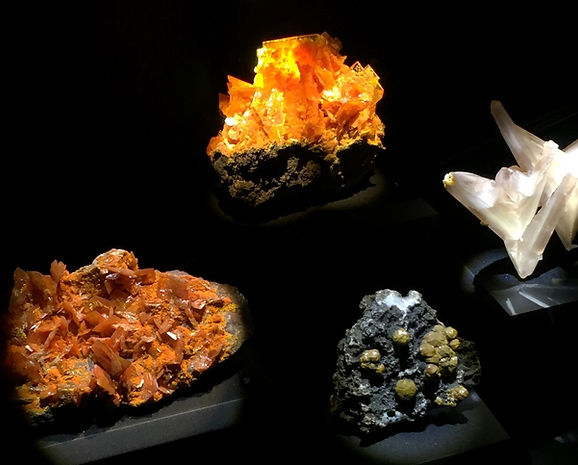
HOUSTON MUSEUM OF NATURAL SCIENCE – CULLEN HALL OF GEMS AND MINERALS
FIELD TRIP STOP – ONE OF THE FINEST COLLECTIONS OF MINERALS ANYWHERE.
LOCATION: The Houston Museum of Natural Science is found in downtown Houston near the intersection of Hermann Drive and Fannin St.
GEOLOGIC FEATURES: Naturally occurring minerals (and gemstones)
DESCRIPTION: The Cullen Hall of Gems and Minerals has on display over 450 unique extraordinary specimens of minerals as found in their natural state, as well as specimens of polished and faceted gemstone jewelry.
Extra: Included in this Field Trip Stop is an extra-credit handout (See the Addendum found below) that I have used in my classroom for students to attend the museum and closely observe the specimens. The handout, however, is useful for any significant display of minerals anywhere. Since the types and locations of mineral specimens within the museum change over the years, the student worksheet was constructed to transcend these changes. One of the primary purposes of this assignment, then, is to get the students to look at specimens for more than a few seconds while carefully considering the minerals’ natural beauty, crystal structure, and formation within the earth.
STUDENT QUESTIONS:
(1) What are the characteristics of a mineral?
(2) How does a Mineral differ from a Rock?
(3) Individual crystals can grow to be quite large. For example, Selenite Gypsum minerals in the Crystal Cave of Mexico can grow larger than telephone poles. What do you suppose can affect the growth (crystal size) of a mineral?
(4) Some crystals are prisms, same are tabular, others are cubes or octahedra. Why do minerals have different shapes?
(5) Mineral crystals can possess the colors of the rainbow. W. hy might different minerals have different colors? Why might the same mineral be found in differing colors (e.g. quartz can be clear, purple, yellow, black, blue).
(6) Do minerals with excellent crystal faces need to have grown into a void? If so, is the void filled with air or with a liquid? Explain.
(7) How are crystals grown in the lab (e.g. blue Copper Sulfate)? What factor distinguishes these lab-produced specimens from actual minerals?.
(8) On the Handout included below within the Addendum, the following crystal forms are included - Prismatic, Prismatic with Pyramid Top, Cubic, Blades, Rhombohedra, and Tabular. Examine Figures 2, 3, 6, 7, 8, 9, and 14 and note the crystal form associated with each of these Figures
(9) CHALLENGE: Amethyst crystals are commonly found in Brazil where they are associated with geodes (formed from voids in Basalt). What are Geodes? How is the Amethyst formed?
(10) CHALLENGE: What factors are likely responsible for the precipitation of a given mineral mined in a particular place?
ADDENDUM: Student Worksheet for HMNS Hall of Minerals
VIDEOS: HMNS Cullen Hall of Minerals tours -
https://www.youtube.com/watch?v=AJhdXKybJ20
https://www.youtube.com/watch?v=BJ2y2vmkpRs (4:05 opal)
https://www.youtube.com/watch?v=XTTqwtikmKo (15:25)
https://www.youtube.com/watch?v=zaFmO9oILUI (0:52)
PHOTOS:
Figure 1 - Malachite (green) and Azurite (blue)
Figure 2 - Quartz
Figure 3 - Rhodochrosite (near Alma, Colorado)
_JPG.jpg)
_JPG.jpg)
_JPG.jpg)
_JPG.jpg)
Figure 4 - Quarttz (var. Amethyst).This specimen is about 6 feet high.
_JPG.jpg)
Figure 5 - Microcline (var. Amazonite) (greenish-blue) and Albite (Colorado, USA) (white)
_JPG.jpg)
Figure 6 - Quartz
_JPG.jpg)
Figure 7 - Intergrown crystals of Pyrite
_JPG.jpg)
Figure 8 - Mesolite (Poona, India)
_JPG.jpg)
Figure 9 - Tourmaline (purple) in Albite (?)
_JPG.jpg)
Figure 10 - Tourmaline (var. Elbaite), Albite (var. Cleavelandite) (white), and Quartz (yellowish). This specimen, about 30 inches across, is from the Pederneira Mine in Brazil.
_JPG.jpg)
Figure 11 - Rhodochrosite
_JPG.jpg)
Figure 12 - Cavansite (Blue) (India)
_JPG.jpg)
Figure 13 - Gypsum (Selenite)
_JPG.jpg)
Figure 14 - Pyromorphite (near Kellogg, Idaho)
_JPG.jpg)
Figure 15 - Wulfenite (orange) (two specimens), Cerrusite (white), Mimetite (on darker groundmass)
_JPG.jpg)
Figure 16 - Sulfur (Sicily, Italy), Ram's Horn Gypsum (Spain); Gypsum (Spain)